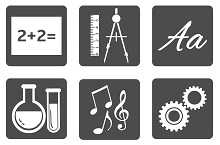Some students get engaged with cross-curricular, large-scale project-based learning
 Here in eastern Ohio, some of our students are embracing their entrepreneurial spirit right at school, engaging in a style of learning that helps make lessons come alive.
Here in eastern Ohio, some of our students are embracing their entrepreneurial spirit right at school, engaging in a style of learning that helps make lessons come alive.
The students, spread throughout nine districts, are working with my organization, the Mahoning County Educational Service Center, which provides educational opportunities—including this foray into project-based learning—to thousands of regional students.
In one recent project, student teams were assigned a region of the United States, and they were challenged to plan and design a self-sustaining restaurant in that area. Nearly every subject was involved as students researched the demographics of their region to determine what kind of restaurant would make sense for their customer base, and identified the renewable energy sources they could use to cut costs and reduce the carbon footprint of their restaurant. Teachers in almost every subject gave up part of their class time to let students work on their projects. In math, they calculated the optimum prices to charge for dishes. In English class, they had to develop a pitch to investors. And in music, they wrote an advertising jingle to promote it.
Designing authentic, performance-based tasks like this can be challenging. But the teachers in these nine pilot districts are getting help from an online service called Defined STEM, which offers project-based curriculum for students in elementary through high school, based on real-world problems or scenarios within the context of an actual career or industry.
Next page: What projects look like
Last spring, our organization received a state grant intended to help schools transition to digital curriculum. We used these funds to purchase subscriptions to Defined STEM for nine of the 20 districts we serve.
Defined STEM’s performance tasks are built from the UBD (Understanding By Design) framework and are introduced with videos of STEM professionals discussing the projects, which allows students to see the performance tasks through the lens of a real career. Each task results in anywhere from five to eight culminating products or activities, all of which address a different cross-curricular topic.
Each performance task also includes clearly defined rubrics for assessing the various products. The projects are designed so they can be modified easily by teachers using something called a Performance Task Editor—basically a tool that lets teachers edit a task, remove or add products, or upload other relevant information.
In another cross-curricular project, students watch a video about Dubai’s Palm Islands, two artificial islands created as resort properties. Working in groups, the students then assume the role of developers planning their own artificial island resort. They must calculate the volume of sand and rock they’ll need to build their island, research the potential environmental impact of their project, develop a marketing plan, and so on.
Moving to a project-based model of instruction represents a big change for educators. At first, some teachers were reluctant to give up the control they were used to having and shift this over to their students. But once they started with a project, and they saw how engaged their students were, they quickly realized the value of this approach.
One teacher told me that her students learned more in one project-based unit than from anything else she had taught all year. Students are likely to remember this information longer as well, because they have internalized the knowledge by applying it within an authentic context.
Using Defined STEM has made it easy for teachers in the nine pilot districts to integrate project-based learning into their curriculum. We’re only in the first year of a two-year pilot, so it’s too early to make any judgments about the initiative—but we’re confident that our student achievement data will show the program has been a success.
In fact, we plan to open a STEM-focused school with a fully project-based curriculum for the 2016-17 school year. Located on the campus of Youngstown State University, the school will be open to students from all across the state.
I absolutely believe that students retain the information better when they learn through a project-based approach as opposed to direct instruction, because it involves them and gets them engaged. That’s what we tend to remember the most from school: those fun projects that made us think—and not necessarily the day-to-day instruction.
What’s more, students are learning about a wide range of potential careers before they get to college. This approach expands students’ horizons and exposes them to new possibilities, inspiring them to pursue careers they might never have considered before.
Jason Braddock is the instructional supervisor for secondary mathematics and STEM education for the Mahoning County Educational Service Center in eastern Ohio.
- TC- What student choice and agency actually looks like - November 15, 2016
- What student choice and agency actually looks like - November 14, 2016
- App of the Week: Science sensor meets your smartphone - November 14, 2016
